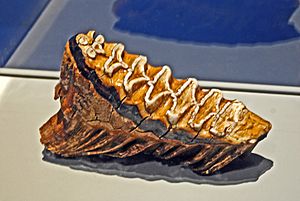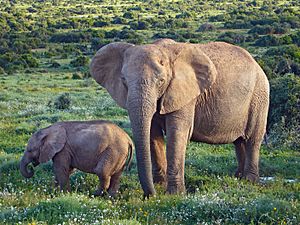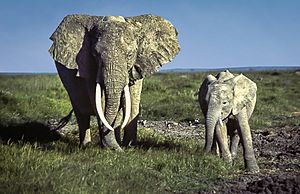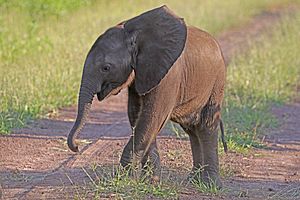African bush elephant facts for kids
Quick facts for kids African bush elephant |
|
|---|---|
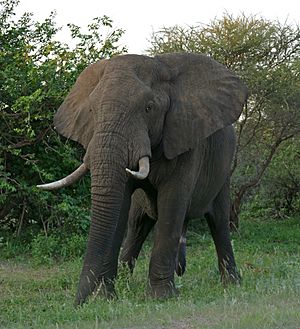 |
|
| A bull in Kruger National Park, South Africa | |
 |
|
| A cow in Mikumi National Park, Tanzania | |
| Conservation status | |
| Scientific classification | |
| Genus: |
Loxodonta
|
| Species: |
africana
|
| Subspecies | |
|
See text |
|
 |
|
| Range of Loxodonta africana (Compiled by: IUCN SSC African Elephant Specialist Group 2021) Resident Possibly Extant (resident) Possibly extinct Extant & Reintroduced (resident) | |
| Synonyms | |
|
Elephas africanus |
|
The African bush elephant is also called the African savanna elephant. It is the biggest animal that lives on land. Male elephants, called bulls, can be almost 4 meters (13 feet) tall at the shoulder. Both male and female elephants have tusks. These tusks start growing when the elephant is 1 to 3 years old and continue to grow throughout its life.
African bush elephants live in 37 countries across Africa. They can be found in many places, like forests, grasslands, woodlands, wetlands, and even on farms. These elephants are social animals. They travel in groups called herds, which are made up of female elephants (cows) and their young. Adult male elephants usually live alone or in small groups of other males. African bush elephants are herbivores, meaning they eat plants. Their diet includes grasses, vines, herbs, leaves, and tree bark.
Scientists first described this species in 1797. Since 2004, the African bush elephant has been listed as Vulnerable on the IUCN Red List. This means their numbers are decreasing. The biggest threats to these elephants are habitat destruction (when their homes are destroyed) and poaching. Poaching is illegal hunting for their meat and ivory tusks.
Contents
What Does the African Bush Elephant Look Like?
The African bush elephant is the largest and heaviest land animal on Earth. The tallest male ever recorded was about 3.96 meters (13 feet) tall at the shoulder. He weighed about 10.4 tonnes (23,000 pounds). On average, male elephants are 3.2 meters (10.5 feet) tall and weigh 6 tonnes (13,200 pounds). Females are smaller, usually 2.6 meters (8.5 feet) tall and weighing 3 tonnes (6,600 pounds).
African elephants have very large ears. They use these ears to release extra body heat and stay cool. Another special feature is their trunk. The trunk is like a long nose combined with an upper lip. It has two "fingers" at the end. This is different from Asian elephants, which only have one "finger." Elephants use their trunks to communicate, pick up objects, and grab food.
Their tusks are also very noticeable. Tusks are actually large, changed incisor teeth that grow bigger throughout the elephant's life. Both male and female African bush elephants have tusks. They use them for fighting, marking their territory, finding food, and digging.
Where Do African Bush Elephants Live?
African bush elephants live in many parts of Sub-Saharan Africa. You can find them in countries like Uganda, Kenya, Tanzania, Botswana, Zimbabwe, Namibia, Zambia, and Angola.
They can live in many different types of places. These include:
- Forests (both warm and mild ones)
- Dry grasslands and woodlands
- Areas that flood sometimes
- Wetlands
- Even farmlands
They can live from sea level up to high mountain slopes. In countries like Mali and Namibia, they even live in desert areas. In Ethiopia, they have been seen as high as 2,500 meters (8,200 feet) above sea level.
What Do African Bush Elephants Eat?
African bush elephants have special molars (back teeth) for chewing plants. As they get older, these molars wear down. New ones grow to replace them. Around age 15, their "milk teeth" are replaced by new ones that last until they are about 30. Then, another set grows, which wears off after age 40. The last set of teeth lasts until they are about 60 to 70 years old. After this, it becomes very hard for them to chew food properly. Some elephants in zoos have lived to be over 80 years old.
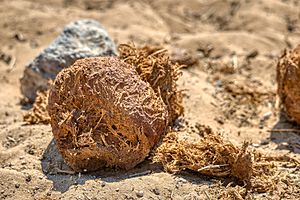
This species eats a lot of plants, about 225 kilograms (500 pounds) every day. They do not fully digest all of it. This means their dung (poop) still has many plant seeds in it. As elephants travel long distances looking for food, they spread these seeds. The seeds then grow in the nutrient-rich dung.
Elephants eat all kinds of plants. They can even knock down trees with their tusks if they cannot reach the leaves.
Social Behavior and Life Cycle
Adult male elephants usually live by themselves. Female elephants and their young live in herds. The oldest female, called the matriarch, leads the herd. Sometimes, an adult male might join them for a short time. But young males usually leave the herd when they become teenagers. They then form groups with other young males. Later, they often live alone, only joining female herds during mating season.
Even when elephants live separately, they remember their families. They recognize each other when they meet again. Sometimes, several female herds might join together for a while. These large groups can have hundreds of elephants.
Mating can happen at any time of the year when a female is ready. When a female is ready, she makes very low sounds called infra-sounds. These sounds can travel for many kilometers and attract males. Adult males arrive at the herd over the next few days. They might fight each other, sometimes causing injuries or even broken tusks. The female shows she accepts the winner by rubbing her body against him. After mating, the male and female go their separate ways.
A female elephant is pregnant for 22 months. This is the longest pregnancy of any mammal! She gives birth to one calf. A newborn calf is about 90 centimeters (3 feet) tall and weighs over 100 kilograms (220 pounds). The baby drinks its mother's milk until it is about five years old. But it starts eating solid food as early as six months old. Just a few days after being born, the calf can walk and follow the herd.
Predators of African Bush Elephants
Adult African bush elephants are so big that they usually do not have natural predators. However, young calves, especially newborns, are at risk. They can be attacked by lions and crocodiles. Rarely, leopards and hyenas might also attack them.
Some groups of lions hunt both baby and young elephants. This happens more often during dry months. In Chobe National Park in Botswana, lions have been seen hunting young elephants. Predators, along with dry weather, cause many young elephants to die.
Protecting African Bush Elephants
The African bush elephant is listed as a vulnerable species. This means their numbers are decreasing overall. However, the situation is different in various regions. In Southern Africa, elephant populations are actually growing by about 4% each year. But in other areas, their numbers are still going down.
In 2006, many elephants were killed illegally in southeastern Chad. This was called an elephant slaughter. Over 100 elephants were killed by poaching near Zakouma National Park during the spring and summer of that year.
Humans are building more homes and farms near areas where elephants live. This can cause problems between elephants and people. Scientists are looking for ways to safely move elephants away from human areas. They found that playing sounds of angry honey bees works very well! Elephants tend to run away when they hear these sounds.
Images for kids
-
Female African bush elephant skeleton on display at the Museum of Osteology, Oklahoma City, Oklahoma
See also
 In Spanish: Elefante africano de sabana para niños
In Spanish: Elefante africano de sabana para niños



